Serviços Personalizados
Artigo
Links relacionados
Compartilhar
RSBO (Online)
versão On-line ISSN 1984-5685
RSBO (Online) vol.11 no.4 Joinville Out./Dez. 2014
Case Report Article
Ultra-thin porcelain laminates to restore esthetics of anterior teeth: case report
André Luíz Bizio I; Gabriel Elias Nascimento ; Natália Spadini de Faria I; Vivian Colucci I; Mateus Silveira Martins Hartmann I; Danielle Cristine Messias I
I DepartmentI of Dentistry, University of Ribeirão Preto – Ribeirão Preto – SP – Brazil
ABSTRACT
Introduction: The ultra-thin porcelain laminates provide the esthetic harmony to the smile compromised by the presence of diastema between maxillary incisors. Objective: To report the dental aesthetic recovery with ultra-thin porcelain laminates, so-called "contact lenses". Case report: Patient sought treatment reporting presence of diastema between the anterior teeth. After the clinical examination, impressions were made to obtain study models and diagnostic wax-up. Home bleaching was conducted using 10% carbamide peroxide for 21 days. Next, the mock-up with bisacrylic self-curing composite resin and the functional impression were conducted. For cementation, dental surfaces were etched with 37% phosphoric acid followed by applying the adhesive system. The resin cement was inserted within internal part of the contact lenses previously treated with hydrof luoric acid and silane, and the prosthetic samples were positioned over the labial surfaces of the anterior teeth. After light-curing, the finishing procedure was performed. Conclusion: Ultra-thin porcelain laminates (contact lenses) were viable, efficient, and conservative procedures for recovering dental esthetic, with no need of invasive procedures.
Keywords: dental ceramics; laminates; esthetic.
Introduction
The increasing patients' interest in better smile appearance leads to an important evolution in cosmetic Dentistry 23. Tooth color, shape, and size alterations are aspects negatively interfering in oral esthetics 1,22. In this context, the presence of diastemas between maxillary teeth compromised the balance and harmony of smile 11.
Diastemas can be closed by orthodont ic treatment and direct and indirect veneers 11. The search for reestablishing the smile esthetic by closing interdental spaces should ideally employ procedures that preserve tooth structure at most 18. Thus, ultra-thin porcelain laminates, so-called "contact lenses" are an esthetic and conservative alternative for diastema closure through little or none tooth structure weariness 6,15,20.
The contact lenses are ultra-thin porcelain veneers, measuring 0.2 to 0.5 mm in thickness, applied onto tooth surface 23. The lenses execution consists in replacing the visible part of enamel by ceramics, which is strongly bonding to tooth surface through resin cements, providing optical, mechanical, and biological properties similar to those of tooth enamel 10,23.
Ultra-thin porcelain laminates has the following advantages: tooth structure preservation because of minimum or none prepare; thermal expansion similar to that of enamel, appearance similar to that of tooth 4,8, color stability, biocompatibility with periodontal tissues, resistance to wear, reinforcement of tooth structure, gloss retention, longer clinical longevity than that of resin composite veneers 5,8.
Additionally to the professional's technical expertise, the materials employed, and prosthetic quality of the veneers, the success of contact lens procedure also depend on the correct case selection 19. The porcelain laminates can be used in cases presenting small teeth, diastema, teeth with lingual inclination and mild color changes 3; abrasions, erosions, and to replace resin composite restorations and to mask tooth pigmentation 6,9,10. All the aforementioned conditions can be associated.
Considering the esthetic quality of "contact lenses", the fast ending of the procedure and the preservation of tooth structure integrity, the lenses can be an option to reestablish the smile harmony in cases requiring the closure of anterior-superior diastemas. Thus, this study aimed to report the case of esthetical-functional reestablishment of the smile through "contact lenses".
Case report
The patient, male, aged 20 years, attended the Dental Clinics of the University of Ribeirão Preto (Unaerp) complaining about his smile appearance (figure 1). At clinical examination, it was observed that the patient presented diastemas among the maxillary and mandibular anterior teeth, with misalignment of long axes and incisal edges of the incisors, and teeth #14, #15, #24, and #25 showing axial inclination towards palatal direction.
After clinical examination and case study, it was verified that the correction of the deficiencies that provide the esthetic impairment of the smile could be achieve through "contact lenses" on the teeth #11, #12, #14, #15, #21, #22, #24, and #25 associated with ceramic fragments on teeth #13 and #23, without tooth structure weariness. To close the mandibular diastemas, resin composite restoration was chosen.
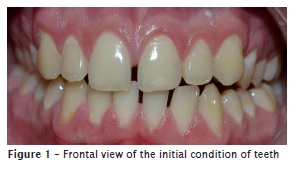
The impressions of the maxillary and mandibular arches were obtained with the aid of irreversible hydrocolloid (Dencri gel, Pirassununga, SP, Brazil) to obtain dental casts that were used to construct bleaching trays and diagnostic wax-up (figure 2). Following, the patient was submitted to tooth scaling through ultrasound, tooth polishing with the aid of prophylatic paste and rubber cups, and the register of initial tooth color (shade A3) (figure 3).
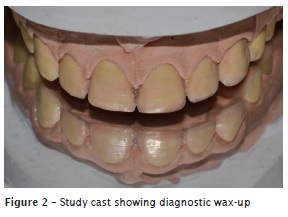
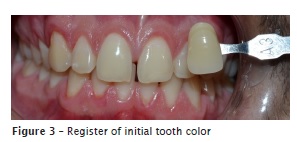
The home-bleaching technique was used with the aid of 10% carbamide peroxide (Whiteness Perfect, Joinville, SC, Brazil) for 21 days. The patient was instructed to use both the maxillary and mandibular trays all night long and avoid intake of food with pigments. After tooth bleaching procedure, the final color of the teeth was shade A1 (figure 4).
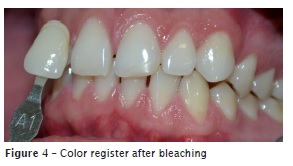
On the study cast with the wax-up, a matrix was constructed with the aid of o condensation silicone (Speedex, Rio de Janeiro, RJ, Brazil), for mock-up purpose. The mock-up was performed with bisacrylic resin (Protempt, 3M-ESPE, St. Paul, MN, USA) inserted inside the matrix and placed on the labial surface of the teeth to be restored (figure 5). The restorative mock-up enabled that the patient predicted the final aspect of his smile (figure 6).
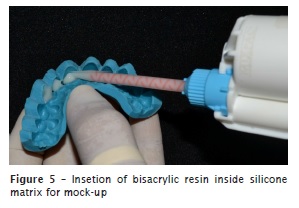
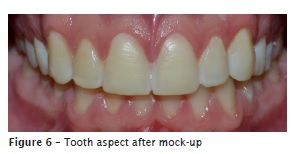
To obtain the working cast, an impression of the maxillary arch was obtained with condensation silicone (Speedex, Rio de Janeiro, RJ, Brazil). The cast was duplicated in refractory cast (Duravest, Cotia, SP, Brazil) for ceramic stratification (Creation CC, Koblacherstrasse, Meiningen, Australia) of the "contact lenses" (figure 7).
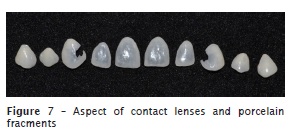
After the adaptation of the laminates on the teeth, their labial surfaces were etched with 35% phosphoric acid (3M ESPE, St. Paul, MN, USA) for 30 seconds, followed by copious washing and drying with absorbent paper. Next, the bonding agent (Adper Single Bond, 3M, ESPE, St. Paul, MN, USA) was applied and light-cured for 20 seconds (Ultraled, Dabi Atlante, Ribeirão Preto, SP, Brazil). The color of the cement was selected after the test through the system provided by the cement's manufacturer (Try In system from Variolink II, Schann, Liechenstein, Germany) (figure 8A). The internal surfaces of the contact lenses were etched with 15% hydrofluoric acid (Angelus, Londrina, PR, Brazil) for 5 minutes, followed by the application of silane agent (Variolink II, Schann, Liechenstein, Germany) for 1 minute. The resin cement was inserted inside the internal part of contact lenses (figure 8B), which were placed onto the tooth surfaces. The excesses of resin cement were removed. The cement was light-cured for 40 seconds, on every contact lens. The polishing procedure of the margins was carried out through ceramic polishers.

After the cementation of the laminates on the maxillary teeth (figure 9), the mandibular teeth were restored with resin composite (Filtek Z350 XT, 3M-ESPE, St. Paul, MN, USA) to close the diastemas among the incisors, following the procedures for adhesive restorations.
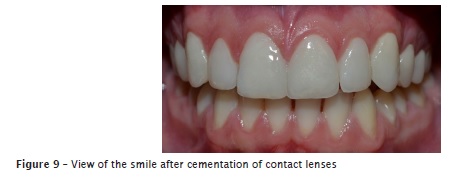
At the ending of the treatment, all diastemas were closed and teeth were aligned (figure 10A, 10B, 10C, and 11).
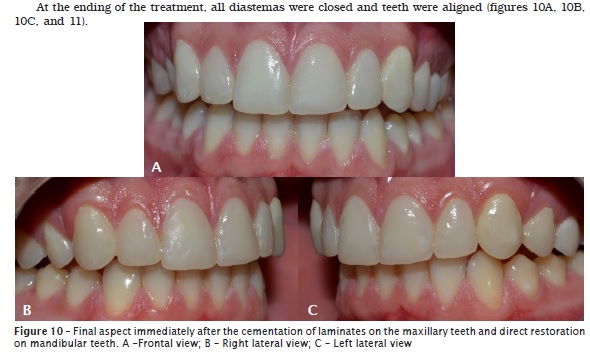
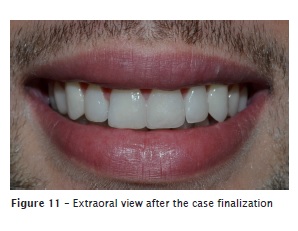
Discussion
In this case report, the patient complained about his smile esthetics, with presence of diastema among maxillary and mandibular incisors and unsatisfactory alignment of maxillary pre-molars. The treatment possibilities comprised either resin composite restorations or porcelain laminates. Although resin composite can be considered as a minimally-invasive procedure, its longevity is limited because of greater susceptibility to discoloration, weariness and marginal defects, which could compromise the long-term esthetic outcome 17. On the other hand, ultra-thin porcelain laminates are considered as conservative and lasting restorations with higher esthetics because of the advancements in both ceramic and adhesive materials and have been indicated for treatments searching balance and harmony of the smile 19,25.
This study aimed to report the recovering of the smile esthetics through the closure of diastemas and realignment of the teeth through ultra-thin porcelain laminates (contact lenses), porcelain fragments, and resin composite restorations.
According to Meijering et al. 12, no significant difference was seen in patient's satisfaction after either porcelain or resin composite veneers, immediately after the ending of the treatment. However, after two years, the patients mostly satisfied were those receiving porcelain veneer.
Because contact lenses have a very small thickness, they have been indicated for the smile harmonization in cases of mild alterations 4,23. Considering that the final color of porcelain laminate is the result of the interaction among the ceramics, tooth substrate, and cement 13, home bleaching technique was chosen. Bleaching agents at low concentration promotes less side effects, such as tooth sensitivity and gingival irritation 7,14, in addition to less damages on superficial enamel topography and to the mechanical properties of tooth structure 21.
Attempting to achieve the color compatibility among the porcelain, tooth, and cement, the cement shade was chosen. This was achieved through shade guides and hydrosoluble pastes whose shades are equal to those of the cements and enable the evaluation of the color onto the tooth 25.
Previous to the definitive procedure to close the diastemas, restorative mock-up was executed. The prediction of the final result by the patient is an important step that leads to reliance 19 and aims at patient's compliance with the treatment 7.
In this present study, the laminates were constructed with feldspathic ceramic. Unlikely the ceramics with low silica amount, feldspathic ceramics have high silica amount, potassium and sodium feldspar 16, and have been used to recover metallic structures and to obtain pure ceramic laminates, through stratification 23. When these porcelains are etched by hydrofluoric acid, they underwent significant micro-morphologic alteration because of the affinity of hydrofluoric acid and silica within glass matrix. The consumption of the silica by hydrofluoric acid consequently leads to the formation of the microporosities that account for the differences observed in the optical properties of these esthetic restorations 23,24. With the superficial corrosion of the glass portion, the superficial defects (e.g.: microcracks) formed during the cooling process are removed, thus preventing crack propagation responsible for the occurrence of early fractures of porcelain restorations 5.
During the cementation procedure of the laminates, the used ceramics required the application of hydrofluoric acid followed by silane application because the latter promotes the surface wettability, greater strength and durability to the adhesion of resin cements 2. The satisfactory adhesion between the laminate and tooth structure, achieved through the cement, is a basic, mechanical, and biological requirement favoring the resistance of the laminate to fracture, the retention of the laminates, better marginal adaptation and reduced risk of microleakage 9.
The use of ultra-thin porcelain laminates has been a procedure commonly indicated to restore tooth esthetics. Notwithstanding, caution should be taken during treatment planning associated with the use of materials and techniques suitable for the case 4.
Conclusion
Considering the final result of this present case report, it can be concluded that ultra-thin porcelain laminates (contact lenses) and porcelain fragments provided satisfactory esthetic and functional outcome to close diastemas and realign the teeth.
References
1. Alsulaimani FF, Batwa W. Incisors' proportions in smile esthetics. J Orthod Sci. 2013 Jul-Sep;2(3):109-12. [ Links ]
2. Borges GA, Shophr AM, Goes MF, Sobrinho LC, Chan DCN. Effects of etching and airboner particle on the different dental ceramics. J Prosthet Dent. 2003 May;30(7):479-88.
3. Christensen GJ. The state of the art in esthetic restorative dentistry. J Am Dent Assoc. 2008 Sep;128(9):1315-7.
4. Cunha LF, Reis R, Santana L, Romanini JC, Carvalho RM, Furuse AY. Ceramic veneers with minimum preparation. Eur J Dent. 2013 Oct;7(4):492-6.
5. Della Bona A, Anusavice KJ. Microstructure composition and etching topography of dental ceramics. Int J Prosthodont. 2002 Mar-Apr;40(27):159-67.
6. Furuse AY, Franco EJ, Mondelli J. Esthetic and functional restoration for an anterior open occlusal relationship with multiple diastemata: a multidisciplinar approach. J Prosthet Dent. 2008 Feb;99(2):91-4.
7. Ghalili MK, Khawaled K, Rozen D, Afsahi V. Clinical study of the safety and effectiveness of a novel over-the-counter bleaching tray system. Clin Cosm Investig Dent. 2014 Feb;6(12):27-33.
8. Guess PC, Schultheis S, Bonfante EA, Coelho PG, Ferencz JL, Silva NR. All-ceramic systems: laboratory and clinical performance. Dent Clin North Am. 2011 Apr;55(2):333-52.
9. Kamada K, Yoshida K, Atsuta M. Effect of surface ceramic treatment on the bond of four resin luting agents to a ceramic material. J Prosthet Dent. 1998 May;79(10):508-13.
10. Kramer N, Lohbauer U, Frankenberger R. Adhesive luting indirect restorations. Am J Dent. 2000 Nov;30(13):60-76.
11. Marais JT. A successful combination of conflicting approaches to diastema closure-a case report. SADJ. 1998 May;53(5):231-4.
12. Meijering AC, Roeters FJ, Mulder J, Creugers NH. Patients' satisfaction with different types of veneer restorations. J Dent. 1997 Nov;25(6):493-7.
13. Meyer Filho A, Vieira LC, Baratieri LN, Lopes GC. Porcelain veneers as an alternative for the esthetic treatment of stained anterior teeth: clinical report. Quintessence Int. 2005 Mar;36(3):191-6.
14. Minoux M, Serfaty R. Vital tooth bleaching: biologic adverse effects-a review. Quintessence Int. 2008 Sep;39(8):645-59.
15. Moon JE, Kim SH, Han JS, Yang JH, Lee JB. Esthetic restorations of maxillary anterior teeth with orthodontic treatment and porcelain laminate veneers: a case report. J Adv Prosthodont. 2010 Jun;2(2):61-3.
16. Nikzad S, Azari A, Dehgan S. Ceramic (Feldspathic & IPS Empress II) vs. Laboratory composite (Gradia) venners; a comparison between their shear bond strength to enamel; an in vitro study. J Oral Rehabil. 2010 Jul;37(7):569-74.
17. Peumans M, De Munck J, Fieuws S, Lambrechts P, Vanherle G, Van Meerbeek B. A prospective ten-year clinical trial of porcelain veneers. J Adhes Dent. 2004 Sep;6(1):65-76.
18. Pini NP, Aguiar FHB, Lima DANL, Lovadino JR, Terada RSS, Pascotto RC. Advances in dental veneers: Materials, applications, and techniques. Clin Cosmet Investig Dent. 2012 Feb;10(4):9-16.
19. Rotoli BT, Lima DA, Pini NP, Aguiar FH, Pereira GD, Paulillo LA. Porcelain veneers as an alternative for esthetic treatment: clinical report. Oper Dent. 2013 Sep-Oct;38(5):459-66.
20. Signore A, Kaitsas V, Tonoli A, Angiero F, Silvestrini-Biavati A, Benedicenti S. Sectional porcelain veneers for a maxillary midline diastema closure: a case report. Quintessence Int. 2013 Mar;44(3):201-6.
21. Soares DG, Ribeiro AP, Sacono NT, Loguércio AD, Hebling J, Costa CA. Mineral loss and morphological changes in dental enamel induced by a 16% carbamide peroxide bleaching gel. Braz Dent J. 2013 Sep-Oct;24(5):517-21.
22. Tjan AH, Miller GD, The JG. Some esthetic factors in a smile. J Prosthet Dent. 1984 Jan;51(1):24-8.
23. Turgut S, Bagis B. Effect of resin cement and ceramic thickness on final color of laminate veneers: An in vitro study. J Prosthet Dent. 2013 Mar;109(3):179-86.
24. Villarroel M, Fahl NJR, Sousa AM, Batista O. Direct esthetic restorations based on translucency and opacity of composite resins. J Esthet Restor Dent. 2011 Apr;23(2):73-87.
25. Xing W, Jiang T, Ma X, Liang S, Wang Z, Sa Y et al. Evaluation of the esthetic effect of resin cements and try-in pastes on ceromer veneers. J Dent. 2010 May;38(1):87-94.
 Corresponding author:
Corresponding author:
Danielle Cristine Messias
Universidade de Ribeirão Preto – Unaerp
Avenida Costábile Romano. n. 2201 – Ribeirânia
CEP 14096-000 – Ribeirão Preto– SP – Brasil
E-mail: dcf.messias@gmail.com
Received for publication: August 14, 2014
Accepted for publication: August 31, 2014













